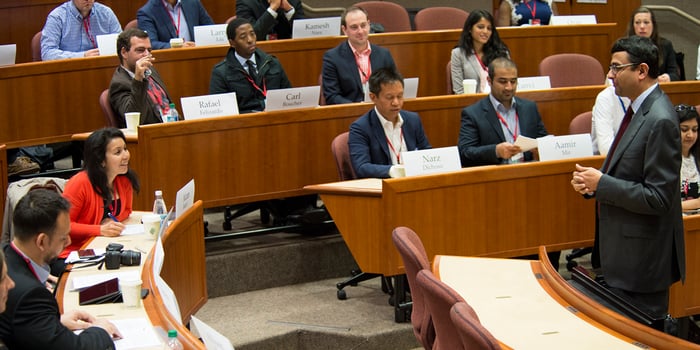
Many first time HBX participants are surprised to learn that often, the professor is not at the center of their HBX learning experience. Instead of long faculty lectures, the HBX learning model centers on smaller, more digestible pieces of content that require participants to interact with each other, try out the concepts they are learning, and learn from real-world examples. The professor fades into the background a bit and lets the focus shift to interviews with executives, industry leaders, and small business owners. Some students might be left thinking, "Wait, where did that professor go? Why am I learning about a grocery store in Harvard Square?"
In the words of The Hitchhiker's Guide to the Galaxy, “don’t panic.” These interviews, or cases, feature leaders at companies of all sizes and provide valuable examples of business concepts in action. This case study method forms the backbone of the Harvard Business School curriculum.
Back in the 1920s, HBS professors decided to develop and experiment with innovative and unique business instruction methods. As the first school in the world to design a signature, distinctive program in business, later to be called the MBA, there was a need for a teaching method that would benefit this novel approach.
HBS professors selected and took a few pages to summarize recent events, momentous challenges, strategic planning, and important decisions undertaken by major companies and organizations. The idea was, and remains to this day, that through direct contact with a real-world case, students will think independently about those facts, discuss and compare their perspectives and findings with their peers, and eventually discover a new concept on their own.
Central to the case method is the idea that students are not provided the "answer" or resolution to the problem at hand. Instead, just like a board member, CEO, or manager, the student is forced to analyze a situation and find solutions without full knowledge of all methods and facts. Without excluding more traditional aspects, such as interaction with professors and textbooks, the case method provides the student with the opportunity to think and act like managers.
Since 1924, the case method has been the most widely applied and successful teaching instrument to come out of HBS, and it is used today in almost all MBA and Executive Education courses there, as well as in hundreds of other top business schools around the world. The application of the case method is so extensive that HBS students will often choose to rely on cases, instead of textbooks or other material, for their research. Large corporations use the case method as well to approach their own challenges, while competing universities create their own versions for their students.
According to Mallory Stark, curriculum services specialist at Baker Library, all this is not a surprise to anyone at the school. For her, what makes the case method truly unique is that it fulfills everyone’s desire for a good story. Mallory recalls how, as an HBS Executive Education student, she encountered a case that focused on the efforts of a hospital CEO in New Orleans and the organization's efforts to respond to the challenges of Hurricane Katrina.
Not only did she end up meeting the CEO in person during the class discussion, but she came to the realization that solid management can mean both saving a company and, sometimes, saving human lives. This is what the case method does—it puts students straight into the game, and ensures they acquire not just skills and abstract knowledge, but also a solid understanding of the outside world.

About the Author
Yannis Normand interned on HBX’s marketing team in January of 2017 and is pursuing a degree in goverment with a focus on economics and finance. He has worked for various institutions in the U.S. and Europe, and has entrepreneurial experience in both Boston and China. He hopes to pursue a career combining law and education and is always on the look out to learn and experience other cultures and places.







